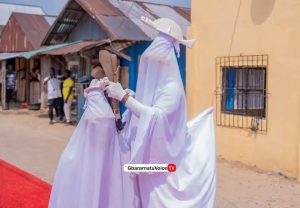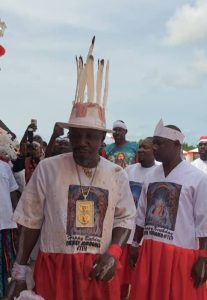Columns
SCREENING THE CULTURAL WONDERS OF ODIMODI THROUGH THE INTEGRATED MASK OF ABADEZONGO (Part 1)

Odimodi, an ancient community in the Iduwini Kingdom, is a place where history and natural beauty blend impeccably. The iconic black and white masquerade flag, majestically erected on the serene waters of Odimodi, proudly announce the commencement of the Abadezongo festivities. The 2025 Abadezongo festival witnessed the presence of His Royal Majesty, Pere Joel Ekeni Ibane Ogiobo the 1X, Grand Pere of Iduwini. His arrival was heralded by a stately siren, followed by a procession of Chiefs from Iduwini, resplendent in their snowy white attire. Also present were dignitaries including Hon. Julius Pondi, the member representing Burutu federal constituency in the House of Representatives, Hon. Forteta Asupa, former member of the Delta State House of Assembly, High Chief Sheriff Mulade of Gbaramatu Kingdom, a distinguished environmental advocate and philanthropist, and Professor Jude Iyabrade Ikporukpo of Niger Delta University, amongst others.
This ancient community presents a striking V-shaped silhouette when viewed from the entrance of the Odimodi River from the Forcados end. Nestled between the majestic mangrove forests lining its opposite waterfront and the lush forest covering its land, Odimodi’s rich history and natural beauty are evident in its vibrant cultural traditions, particularly the renowned Abadezongo Festival. The town and its people, especially the initiated members of the masquerade cult, were decked in costumes that reflect the colours of the masquerade of the moment. The predominant colours of the masquerade festivities – black, white, and red – hold profound symbolic significance. Black represents the mystery and profundity of the divine, while white signifies purity, clarity, and spiritual illumination. The red carpet, adorning the floor, embodies the life-giving energy, vitality, and sacrifice that connect the community to the divine essence. These colours, carefully chosen and plaited together, create a rich blend of meanings, linking the masquerade celebration to the sacred and the divine. The Abadezongo head mask, hosting radiant energies and converging secrets and mystical forces, is a celebrated divine symbol that gives the festival precision and grandeur. A festival that possesses a robust human capacity that spans all ages and skill levels, enabling the community to execute the celebration with precision, passion, and magnificence.

The masquerade’s dance repertoire is a captivating display of Ijaw cultural heritage. From the elegant “agene” to the vibrant “Igime” and “Egbeplesei” and the dynamic “Karabakara masquerade dance,” each dance form showcases the artistic expression of the Ijaw people.
Astonishingly, the drummers assume a dual role, not only providing the rhythmic heartbeat but also serving as the singers. Their absorbing drumbeats and chants blend in perfect harmony to create an enchanting musical experience.
On the 27th of January, when the Odimodi Sun of Heaven kissed the land in the soft Abadezongofied dawn, Finkorobena, a vanguard or avant-garde Abadezongo masquerade, emerges, clad in glittering white attire with effortless elegance, and unleashes a fascinating dance performance, showcasing the epitome of aesthetic refinement. However, its tranquil character is short-lived, as it suddenly transforms into a playful and mischievous entity, engaging in a sportive game of tag, chasing after individuals with mock intent to “cut” them, leaving a trail of laughter and amusement in its wake.
Although deeply rooted in tradition, the Abadezongo masquerade performance impeccably blends culture and technology. A microphone appropriated by the cultural commentator amplifies the energetic rhythms, elevating the spectacle to new heights and intensifying the emotional impact of the dance. A distinctive highlight of the Abadezongo festival is the innovative inclusion of a masquerade commentator, who provides vivid play-by-play descriptions of the masquerade’s intricate dance movements, symbolic gestures, and cultural significance, thereby enriching the audience’s understanding and appreciation of the performance.
Following the masquerade performance, traditional dancers swiftly assemble, forming a vibrant circle around the arena stage. With infectious energy, they break into a captivating display of customary dance sequences, entertaining the audience with their synchronised movements and rich cultural heritage. Thereafter, dancers adorned in pristine white attire take to the stage, moving in harmonious pairs to showcase their mastery of traditional dance. With precise steps and fluid gestures, they demonstrate their artistry, weaving a captivating fabric of movement and rhythm that rivets the audience. They dance and run to their back up audience including the drummers, in the spirit of the celebration to energise through chants such as Asakie! With a responsorial chant hee! To sustain the cadence of the Abadezongo artistry.
As the festival unfolds rhythmically, it transported us to the art of praise singing. Throughout the celebration, energetic young praise singers who also danced periodically make their way through the gathering, lavishing dignitaries and esteemed guests with elaborate praise names and poetic accolades, adding a dynamic and festive touch to the proceedings. The logic is to acknowledge their presence in the town and at the festival arena.
The Centre stage masquerade is considered a representative of the gods and spirits of the land and thus, given the respect they deserve by everyone. The masquerade demands respect like a dominant god or he strikes viciously. In a poignant display of admiration, men clad in white attire humbly bow their heads as the masquerade moves toward them, acknowledging its spiritual ascendancy and the sacred power it embodies. Their gestures convey a deep sense of love, respect, and awe. The Abadezongo masquerade is a larger than art festival because it crosses the boundaries of art in some noticeable ways. The natural cuts it does to celebrate his heroism and its therapeutic practice.
In a breathtaking spectacle, the Finkorobena masquerades ascended to the pinnacle of a towering wooden fence, where the lead masquerade performed an astonishing dance, leaving the audience in utter amusement. Meanwhile, the awestruck acolytes knelt at the base of the high fence, imploring the masquerade to descend from its lofty perch. Their pleas for the masquerade to descend from the towering altitude it has climbed to are a testament to the reverence and awe inspired by the masquerades’ death-defying feat. A fine and effective dramatic spectacle.
The evening session of the festival reached its climax with the emergence of the revered Abadezongo masquerade, the central and fundamental masquerade of the festival, feared and respected in equal measure, much like the legendary Olorogun masquerade of Ayakoromo. As the masquerade began its procession, the crowd of dignitaries sat in rapt attention, exercising utmost caution to avoid the dreaded cuts of Abadezongo, while the townspeople who challenge the masquerade assembled in the various streets of Odimodi.
But how did the Odimodi people come in contact with Abadezongo? Is it a creation of their cultural genius or it a revealed or received masquerade? As recounted by a seasoned historian, widely called and known as Nepa, Abadezongo masquerade was discovered by Otolo Kokioko, the founder of Odimodi, during one of his fishing expeditions at the Odimodi River. He brought the mask head back to the community where it was creatively reproduced, and all the ceremonies leading to its celebration were perfected physically and spiritually. The biannual festival, according to Nepa takes more than three months to receive spiritual endorsement. The spirits must agree before the festival is celebrated.
The Abadezongo masquerade’s compulsive performance like the vanguard masquerade, Finkorobena, oscillated between playful pursuits of the crowd and intermittent returns to the festival arena, where it would burst into energetic dance routines, hypnotising the audience with its captivating artistry. The masquerade is a distinctly masculine entity, comprising three imposing figures clothed entirely in black attire, from their enigmatic masks to their rattling toes, exuding an aura of mystique and reverence. From the historic interpretation and wisdom of Nepa.
“Abadezongo” as a name describes the roughness, harshness, and near-boiling and disorderly nature of the sea waves, which is a major characteristic of the masquerade over time. The sea waves go violent and pacific. The name of the legendary masquerade is literally a description of the boisterous or chaotic, widely agitated or turbulent motion of the sea water. The uniqueness of Abadezongo is not in its aesthetics but in its dramatisation and embodiment of the nature of the rough circles or labyrinth of the sea waves. By extension, Abadezongo parades a lifestyle that resembles the way some humans and leaders are natured. He is a three dimensional spirit masquerade that transforms into variety of moods and characterization, including the ugly, the bad and the good.
In addition to its mesmeric performances, the Abadezongo masquerade also played a sacred role in the purification and healing of individuals. With great reverence, it sprinkles holy water from its revered spring pot, collected from several rivers of Iduwini extraction, believed to possess profound healing properties. Legend has it that the mere sprinkling of this sacred water on the human body can bring solace, comfort, restore deep cuts and reestablishment to those who receive it.
In a thrilling fusion of tradition and sportsmanship, the Abadezongo masquerade presents a unique challenge. A young man, carrying a pot of palm wine, kneels encircled by the imposing precarious masquerades. With a cup filled with palm wine held aloft, the youth dares brave participants to come forward and claim a drink. However, there’s a catch: to succeed, one must outwit the masquerades’ cunning traps and intimidation tactics. Only those who demonstrate agility, strategy, and courage will be rewarded with a refreshing sip of palm wine, to earn the admiration of the crowd and the respect of the Abadezongo masquerades.
Close to curtain fall, the masquerade takes centre stage with its scintillating dance routines and purification rituals. The Abadezongo’s triumphant return to their sacred groove is met with a symbolic ritual, as devoted acolytes feed the masquerades with a live sacrificial cock. In a profound display of worship, the blood of the offering is ceremoniously poured on the head of the lead Abadezongo masquerade, anointing it with sacred vitality. The ritual significance of pouring the blood of the offering on the head of the Abadezongo masquerade could be rejuvenation and revitalization. The blood may symbolise life force, and pouring it on the masquerade could be a way to revitalize and recharge its spiritual energy. The Abadezongo festival is also about purification and cleansing: Blood is often associated with purification and cleansing in many cultures. This ritual could be a way to cleanse the masquerade of any negative energies and restore its sacredness. Pouring blood on the masquerade’s head may be a form of anointing, symbolising the transfer of spiritual power and authority. The ritual is also an emphasis on the renewal of spiritual connection: This ritual could serve as a way to renew the tripartite spiritual link between the masquerade, the community, and the divine realm. The offering of blood may represent a symbolic sacrifice, acknowledging the masquerade’s importance and the community’s gratitude for its presence. All of these point to the godly status of Abadezongo. These interpretations highlight the potential ritual significance of this practice, emphasizing themes of spiritual renewal, purification, and empowerment.
As the Abadezongo masquerade concluded its intense and awe-inspiring performance, transforming from the violent to the peaceful nature, the arena stage erupted into a vibrant spectacle that assembles all in the community that attended the festival. The crowd surged forward, eager to join in the celebratory festivities, as the Abadezongo transitioned into lively dance steps. Its energetic rhythms became infectious and irresistible.
This arena stage presented a heartwarming and unifying spectacle, as people from all walks of life, spanning generations, came together to celebrate. The crowd was a vibrant tapestry of young and old, united in their enthusiasm and joy, as they revelled in the festive atmosphere. The arena erupted into a cacophony of joy, as songs, drums, and dances filled the air, with both organised and spontaneous performances taking centre stage. The infectious energy transcended age and social status, with high-ranking personalities and children alike lost in the revelry. It was amidst this electrifying celebration that the matchet-wielding Abadezongo masquerade made a dramatic entrance, dancing with reckless abandon before cutting the raised wooden fence that separated the drummers from the enthralled audience. As dictated by ancient custom, the lead Abadezongo masquerade assumes its sacred seat and with an air of reverence, the masquerade then bestows divine blessings and favours upon the faithful who approach it, seeking spiritual guidance and protection. This sacred ritual continues until the fading light of day gives way to the night.
The Abadezongo Festival holds profound social significance in Odimodi serving as a vital channel of cultural preservation, social cohesion, and community identity. It is a cherished tradition that has been passed down throughout generations, preserving the Odimodi people’s rich cultural heritage. The festival showcases the community’s unique customs and practices, such as the masquerade performances, traditional dances, and sacred rituals. Again the festival provides an opportunity for the community to share stories, myths, and legends, preserving their language and oral tradition.
Remarkably, Abadezongo brings the community together to foster a sense of unity and shared identity among the people and provides voice and platform for social interaction, strengthening relationships as well as promoting a sense of belonging among community members. Significantly, the festival’s emphasis on reconciliation and forgiveness helps to resolve conflicts and promote peace within the community. Interestingly, Abadezongo is a source of cultural pride for the Odimodi people who celebrate their unique heritage and traditions.
The festival plays a significant role in shaping the Odimodi community’s identity, particularly among young people who learn about their cultural heritage through participation. Abadezongo stimulates the local economy with community members selling traditional crafts, food, and drinks during the festival. The festival provides an opportunity for community members to develop entrepreneurial skills, promoting economic empowerment and self-sufficiency and serves as a cultural education platform, teaching community members, particularly young people, about their heritage and traditions.
No doubt, Abadezongo is important to the Odimodi people in many ways. The festival provides an opportunity for community members to develop skills such as dancing, singing, and craftsmanship and ensures the intergenerational transmission of cultural knowledge, customs, and practices, thus safeguarding the community’s cultural heritage for future generations.
This magnificent celebration is more than just a masquerade festival; it is an immersive experience that showcases the community’s history, spirituality, and artistic expression. In essence, the Abadezongo Festival is a multifaceted celebration that weaves together the intricate threads of Odimodi culture, spirituality, and community. Thus, creating a vibrant drapery that reflects the richness and diversity of the Ijaw people in the African continent.
Prof. Benedict Binebai
(Igumugumu) writes from Odimodi
Columns
Mastering the Art of Delegation :The Key to Business Growth

By Nicolas Leighton
In the journey of building a successful business, many entrepreneurs find themselves wearing every hat-juggling sales, operations, customer service, and beyond. But as the business grows, so does the need for a team and with it, a new challenge emerges :learning to let go.
For many business owners, delegation feels like a risk. There’s a fear that employees won’t meet the high standards set by the founder-often for good reason. After all, no one is likely to match the owner’s passion or commitment. But real growth demands more than personal efforts’, it requires a team that not only supports the vision but is empowered to help drive it forward.
The secret to successful delegation lies not in simply offloading tasks, but in transforming team members into strategic contributors. Here’s how smart entrepreneurs are doing it.
Share the vision – and the “Why” Behind it
Leadership is more than issuing directives ‘, it’s about aligning everyone with a common purpose. Business owners must go beyond surface – level goals and communicate the deeper mission that drives their decisions. When teams understand the purpose behind the work and see how their roles fit into the broader vision – they become more invested in the outcome.
One way to do this is through transparency. Sharing key business data, including Financials and performance metrics can foster trust and give employees context for their efforts. It shifts their perspective from executing tasks to being part of a bigger journey
Empower, Don’t Micromanage
Entrepreneurs often fall into the trap of micromanagement, believing it’s the only way to maintain quality. But micromanaging stiles innovation and undermines trust. Instead of assigning isolated tasks,business leaders should hand over full processes or projects, allowing team members to take ownership from start to finish.
Delegation should be outcome – based – focused on the result rather than the method.
This approach gives employees the freedom to make decisions within clear boundaries. For example, managers might be empowered to approve expenses up to a certain limit, encouraging initiative without losing oversight.
Equally important is preventing “reverse delegation”, where problems are handed back up to the owner. Instead, leaders should encourage solution – oriented thinking, promoting staff to propose answers rather than than rely on top – down problem – solving.
Incentivize Impact
Passion can’t be expected without purpose – and a paycheck alone rarely ignites high engagement. Motivation a team means understanding what drives them individually. While financial incentives like bonuses or profit-sharing can be effective , non-monetary rewards such as flexible work hours, additional time off or professional growth opportunities can be equally compelling.
Each employee is different. and it’s the leader’s job to identify what motivates their team and align incentives with company goals.
Build a Culture of Feedback
Delegation is a dynamic skill that improves over time through open dialogue. When expectations aren’t met, it’s often due to unclear instructions or lack of resources – not incompetence. Rather than abandoning delegation after one poor result, leaders should establish regular feedback loops. Constructive conversation helps clarify expectations and refine processes for better outcomes.
Ultimately, delegation isn’t just a management tactic – it’s a leadership necessity. It takes practice, patience, and sometimes outside support. Working with a business coach can provide the perspective and strategies needed to delegate effectively and lead with confidence.
In today’s fast – moving business world, the most successful entrepreneurs aren’t those who do it all themselves – they’re the ones who build teams capable of thinking and acting with ownership. When done right, delegation doesn’t just lighten the load – it multiplie the impact.
Columns
Oporoza: An Emerging Site of Cultural Gravity

By Prof. Benedict Binebai
Oporoza, sacred heart of the Gbaramatu Kingdom, pulsates with ancient rhythms and whispers of the past. This hallowed town, steeped in mystique, beckons travellers to partake in its vibrant traditions and customs. As a cultural lodestar, Oporoza draws seekers of knowledge and wisdom, offering a glimpse into the soul of the Gbaramatu people.
Born from the ashes of military invasion, Oporoza stands as a testament to the resilience of a community that refused to be silenced. Its people, driven by a fierce determination to resist political oppression, economic exploitation, and environmental degradation, rose from the ruins to reclaim their heritage and rebuild their lives.
Right now, at the Amaseikumor Festival, the air is alive with the beat of drums, the sway of traditional dance, and the warmth of hospitality. Visitors are enveloped in a world of artisanal splendour, where local crafts and cuisine weave a tale of resilience and creativity. The Gbaramatu Kingdom’s heritage reveals the community’s unyielding spirit, a symphony of myth and legend that echoes through the ages of history and culture.
At the Oporoza sacred spaces, history and myth converge, revealing the mysteries of a people bound to their land and traditions. The town’s cultural gravity warps time and space, drawing all who enter into its orbit of wonder and discovery. As a keeper of ancient tales and customs, Oporoza stands sentinel, guarding the essence of the Gbaramatu Kingdom.
Leadership and Legacy
At the heart of Oporoza’s resurgence is High Chief Government Oweizide Ekpemupolo, a prince of the esteemed Okenrenkoko ruling house of Gbaramatu As a spiritual master of the revered ancient Agadagba status, Chief Ekpemupolo embodies the wisdom, strength, and charisma that have guided his people through generations.
His leadership has been instrumental in fostering prosperity, peace, and cultural revival in Oporoza. Through his vision and dedication, the community has experienced a renaissance with a renewed focus on traditional values, arts, and heritage.
As a symbol of hope and resilience, Chief Ekpemupolo’s legacy continues to inspire and unite the people of Gbaramatu, ensuring the kingdom’s rich cultural heritage endures for generations to come.
Celebrating Cultural Heritage
Chief Government Ekpemupolo’s vision for the annual cultural festival strongly expresses his deep love for Ijaw tradition and identity. By celebrating the rich cultural heritage of the Gbaramatu Kingdom, he aims to spiritually reconnect with the past, honouring the ancestors and traditions that have shaped the community.
Through this magnus opus, Chief Ekpemupolo seeks to share the values of Ijaw tradition with the world, promoting love, kindness, and oneness. The festival transcends revenue generation, focusing on cultural exchange, education, and mutual understanding.
It’s an opportunity for people from diverse backgrounds to experience the vibrant culture of the Gbaramatu Kingdom. By taking Ijaw tradition to the global arena, Chief Ekpemupolo’s initiative fosters greater appreciation and respect for the community’s heritage.
The festival becomes a platform for intercultural dialogue, enriching both the local community and global audiences. Through this celebration, Chief Ekpemupolo’s vision of love, kindness, and oneness resonates worldwide.
May Oporoza’s cultural flame continue to burn bright, illuminating the path for generations to come, and may its people forever thrive, their heritage, a beacon of hope and identity in a rapidly changing world.
Columns
Column: The Song in the Emerging Wind of Amaseikumor Festival of Gbaramatu.

By Prof. Benedict Binebai
As the celestial drums of the gods beat in harmony with the rhythmic waves of the Niger Delta, the Amaseikumor Fiesta awakens, summoning all from the four cardinal po8nts to witness the grandeur of Gbaramatu’s rich cultural heritage! Come and behold the majestic procession of colourful masquerades, the symbolic embodiment of the ancestral spirits that guard the kingdom.
The Amaseikumor fiesta is here again, Immerse yourself in the splendour of Gbaramatu and the ijaw nation. a resplendent celebration of Gbaramatu’s rich cultural heritage!
Come and witness the majestic procession of colourful masquerades, the rhythmic cadence of traditional drums, and the vibrant display of ancestral worship.
Be moved by the primal essence of the Ijaw course through your veins as you revel in the grandeur of this ancient kingdom.
Do not hesitate to be present to unveil the mystique ofAmaseikumor Festival by stepping into the enchanting realms of Festival, where the veil and physical realms of spiritual worlds is lifted!
You will marvel at the elaborate rituals, the symbolic dances, and the reverent homage paid to the gods of the land. As the festival’s primal energy courses through the air, you will be transported to a world of ancient wisdom, mystical power, and timeless beauty.
Get ready to be electrified by Amaseikumor Oge, Gbaramatu’s most screened and anticipated cultural extravaganza! This spectacular celebration is a symphony of colours, sounds, and rhythms that will leave you breathless and yearning for more. From the pulsating beats of the drums to the dazzling display of traditional attire, every moment of this festival is an aesthetic and spiritual establishment of the indomitable spirit and creative genius of the Gbaramatu people.
Join the legendary journey of discovery of Amaseikumor Festival where the ancient traditions and mystical energies of Gbaramatu await your arrival!. As you navigate the festival’s vibrant landscape, you will encounter a rich fabric of cultural practices, time-honoured rituals, and warm hospitality. The rise and fall of the pleasant sea waves, the pacific wind, and the melody of earthly sounds are erected to welcome you. Whether you are a curious traveller, a cultural enthusiast, a prince of tourism or simply a seeker of new experiences, this festival promises to be an unforgettable journey of discovery and enchantment.
